Black holes, magnetism and cancer Understand article
Science in School is published by EIROforum, a collaboration between eight of Europe’s largest inter-governmental scientific research organisations. This article reviews some of the latest news from the EIROforum members (EIROs).

EIROforum
EIROforum combines the resources, facilities and expertise of its member organisations to support European science in reaching its full potential. To learn more, see: www.eiroforum.org
CERN: Tantalising hints of Higgs
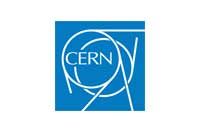
The hunt for the Higgs boson has entered its decisive phase, as announced in a seminar on 13 December 2011. If they exist, Higgs bosons are short-lived and decay in many different ways. Both ATLAS and CMS, the two largest experiments at CERN’s Large Hadron Collider (LHC), have observed an excess of gamma rays (highly energetic photons) in the mass region where the Higgs boson would be expected to register.
However, even the 500 trillion proton–proton collisions observed in each experiment – thanks to a brilliant performance of the LHC during 2011 – are not enough.
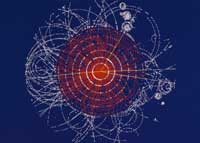
boson decaying into four
muons; the tracks of the
muons are shown in yellow
Image courtesy of CERN
With a statistical significance between two and three standard deviations, the signals do not yet allow the scientists to claim that they have finally discovered the long sought-after particle.
About four times more collisions will be needed to finally conclude whether the Higgs boson exists. If all goes well, the LHC will provide these data by the end of 2012, when it will become clear if the standard model of particle physics can be considered complete.
To learn more, see the press release:
http://press.web.cern.ch/press/PressReleases/Releases2011/PR25.11E.html
To find out more about the LHC, see:
Landua R, Rau M (2008) The LHC: a step closer to the Big Bang. Science in School 10: 26-33. www.scienceinschool.org/2008/issue10/lhcwhy
Landua, R (2008) The LHC: a look inside. Science in School 10: 34-45. www.scienceinschool.org/2008/issue10/lhchow
Based in Geneva, Switzerland, CERN is the world’s largest particle physics laboratory. To learn more, see: www.cern.ch
EFDA-JET: A snowball in hell
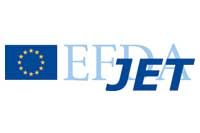
During the recommissioning of the Joint European Torus (JET) after an 18-month refurbishment period, scientists have injected the proverbial snowball into hell.
The snowball in question is a 3 millimetre pellet of frozen deuterium, at approximately -260 degrees Celsius. Hell is the plasma inside JET, ionised deuterium gas at about 100 million degrees Celsius. These experiments are part of the quest for nuclear fusion, an energy source based on nuclei colliding and coalescing into heavier elements.
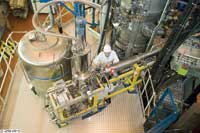
a gas-powered machine gun
capable of firing up to 50
small frozen pellets of
deuterium fuel per second
into the hot plasma
Image courtesy of
EFDA-JETCaption
Surprisingly, contrary to popular legend, the ‘snowball’ has a significant effect on ‘hell’. The pellet injection system is designed to prevent plasma instabilities in which the hot gas momentarily escapes its magnetic cage, diffusing a lot of energy and many of its constituent particles. The injection of a cold pellet actually triggers instabilities as well, but if pellets are injected at regular intervals, scientists have found that the many small instabilities produced reduce the number of large instabilities, thereby allowing the plasma pulses to operate for longer.
The way is now clear to begin the process of slowly turning up the new heating systems to test the many other new components.
To find out more, see:
Rüth C (2012) Harnessing the power of the Sun: fusion reactors. Science in School 22: 42-48. www.scienceinschool.org/2012/issue22/fusion
Situated in Culham, UK, JET is Europe’s fusion device. Scientific exploitation of JET is undertaken through the European Fusion Development Agreement (EFDA). To learn more, see: www.efda.org
EMBL: Cancer research for schools

On 9 December 2011, more than 200 enthusiastic pupils and teachers gathered at the European Molecular Biology Laboratory (EMBL) for the EMBL Insight Lecture 2011. To celebrate the International Year of Chemistry, Maja Köhn, who works in the highly interdisciplinary field of chemical biology, gave a lecture on ‘Chemistry and biology – strong allies in the fight against cancer’.
Her cross-disciplinary team of organic chemists and molecular biologists works on designing molecules that inhibit proteins involved in disease mechanisms. The scientists want to understand the role of phosphatases in cancer metastasis, the molecular mechanisms leading to disease and how the activity of these proteins can be modulated. During her lecture, Maja demonstrated how inhibitors of phosphatases are designed by combining molecular biology, biochemistry and synthetic chemistry.
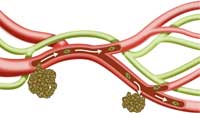
Image courtesy of André-Pierre
Olivier
The EMBL Insight Lectures series is produced by EMBL’s European Learning Laboratory for the Life Sciences (ELLS) to inform young people about current trends in life-science research and how this research influences our everyday lives. Maja’s lecture is one of a growing list of EMBL Insight Lectures available at: www.embl.org/ells/insightlectures
EMBL is Europe’s leading laboratory for basic research in molecular biology, with its headquarters in Heidelberg, Germany. To learn more, see: www.embl.org
ESA: Take your classroom into space
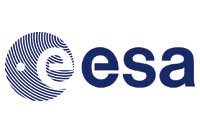
PromISSe is the fourth European long-duration mission to the International Space Station (ISS), which began on 23 December 2011 with the arrival at the ISS of the European Space Agency’s astronaut André Kuipers and his Russian-American colleagues. André and his colleagues will remain in space until mid-May 2012.
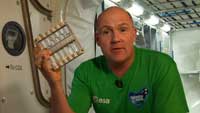
with an experiment to
demonstrate properties and
behaviour of wet foams in
space
Image courtesy of ESA
During this 148-day mission André is taking part in experiments on human research, fluid physics, materials science, radiation and solar research, mostly in the European space laboratory Columbus. School students can join in too, taking part in many science activities being transmitted from space to classrooms across Europe.
André is also encouraging a new generation of space explorers to stay fit and ‘Train Like an Astronaut’, with a NASA-led educational programme for 8- to 12-year-olds.
Thousands of pupils are invited to perform physical exercises and classroom lessons, competing with teams from around the world.
To learn more about the Columbus laboratory, see:
Wegener A-L (2008) Laboratory in space: interview with Bernardo Patti. Science in School 8: 8-12. www.scienceinschool.org/2008/issue8/bernardopatti
For more details of the in-orbit demonstration for children, see: www.esa.int/SPECIALS/PromISSe/SEMU1FJ37SG_0.html or use the direct link: http://tinyurl.com/7y7ahy9
To find out more about the ‘Train Like an Astronaut’ project, see: www.esa.int/SPECIALS/PromISSe/SEMK0FJ37SG_0.html or use the direct link: http://tinyurl.com/76hk2vy
ESA is Europe’s gateway to space, with its headquarters in Paris, France. For more information, see: www.esa.int
ESO: Doomed cloud approaches black hole

Astronomers using the European Southern Observatory’s Very Large Telescope have discovered a gas cloud with several times the mass of Earth accelerating fast towards the black hole at the centre of the Milky Way. This is the first time ever that the approach of such a doomed cloud to a supermassive black hole has been observed.
Over the past seven years, the speed of this gas cloud has nearly doubled, reaching more than 8 million kilometres per hour. In mid-2013 it will pass at a distance of only about 40 billion kilometres from the event horizon of the black hole. In astronomical terms, this is an extremely close encounter with a supermassive black hole. The cloud’s edges are already starting to shred and disrupt and it is expected to break up completely over the next few years.
“The idea of an astronaut close to a black hole being stretched out to resemble spaghetti is familiar from science fiction. But we can now see this happening for real to the newly discovered cloud. It is not going to survive the experience,” explains Stefan Gillessen of the Max-Planck Institute for Extraterrestrial Physics, the lead author of the paper describing the discovery.
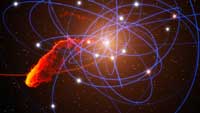
Image courtesy of ESO / MPE / Marc Schartmann
To find out more, see the press release (www.eso.org/public/news/eso1151) or the research paper:
Gillessen S et al. (2012) A gas cloud on its way towards the supermassive black hole at the Galactic Centre. Nature 481: 51-54. doi: 10.1038/nature10652
Download the article free of charge below, or subscribe to Nature today: www.nature.com/subscribe
ESO is the world’s most productive astronomical observatory, with its headquarters in Garching near Munich, Germany, and its telescopes in Chile. For more information, see: www.eso.org
ESRF: The chemistry of attraction: magnetism
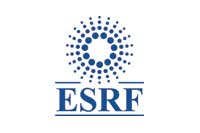
A problem that has puzzled scientists for 70 years has finally been solved. Magnetite – the most magnetic of all minerals – stops conducting electric currents at low temperatures, a discovery made in 1939 by Dutchman Evert Verwey. The reasons remained controversial until a group of scientists working at the European Synchrotron Radiation Facility (ESRF) fired an intense X-ray beam at a tiny, perfect crystal of magnetite at very low temperature. They observed a subtle rearrangement of the mineral’s chemical structure, trapping electrons within groups of three iron atoms, inhibiting them from transporting an electrical current.
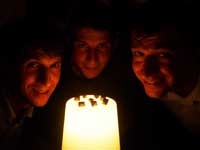
magnetite crystals
Image courtesy of Ana Wright
Magnetite (Fe3O4) was discovered more than 2000 years ago. It gave rise to the original concept of magnetism and was used to build the first magnetic compass. When it crystallises from volcanic magma, magnetite conserves the direction of Earth’s magnetic field, which was key to the discovery that this field had reversed direction in the past. Tiny crystals of magnetite are also found in insect and pigeon brains and are thought to play a role in these animals’ ability to fly back home over long distances.
To find out more, see:
Attfield JP (2011) Condensed-matter physics: A fresh twist on shrinking materials. Nature 480: 465–466. doi: 10.1038/480465a
Download the article free of charge below, or subscribe to Nature today: www.nature.com/subscribe
Situated in Grenoble, France, ESRF operates the most powerful synchrotron radiation source in Europe. To learn more, see: www.esrf.eu
European XFEL: Building the world’s largest X-ray laser
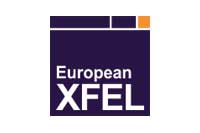
The year 2011 has shown good progress on the construction and development of what will be the world’s most brilliant source of ultra-short X-ray pulses. The European XFEL will offer new insights into the nano-world, revealing the structures of biomolecules and allowing chemical reactions to be ‘filmed’.
With most of the tunnel boring completed, tunnel builders have started to put in the concrete floor elements. All told, the facility is 3.4 kilometres long and has 5.7 kilometres of underground tunnels. The tunnel for the linear accelerator, which will speed electrons up to very high energies, is now ready for the installation of technical equipment.
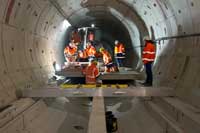
installations
Image courtesy of European
XFEL
At the far end of the accelerator, the tunnel splits into a number of smaller tunnels, where X-ray light flashes will be generated by forcing the electrons on a tight slalom course through a line of magnets called undulators. The first prototypes of the undulator segments have been delivered. Significant milestones have been reached in the development of the instruments that scientists will use to carry out their experiments and of other technical equipment. European XFEL expects to start operation in 2015.
European XFEL is a research facility currently under construction in the Hamburg area in Germany. It will generate extremely intense X-ray flashes for use by researchers from all over the world. To learn more, see: www.xfel.eu
ILL: Symmetry in quasicrystals
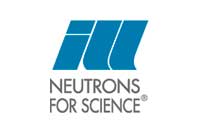
ILL is an international research centre at the leading edge of neutron science and technology, based in Grenoble, France. To learn more, see: www.ill.eu
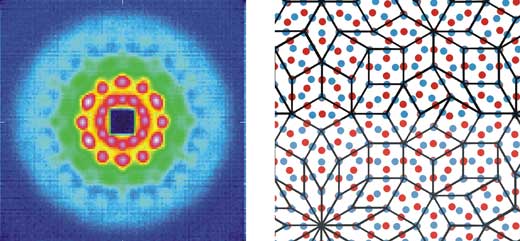
Image courtesy of instrument D11 / ILL and Stephan Förster / Universität Bayreuth
Resources
- The two cited Nature papers can be downloaded free of charge here:
- Gillessen S et al. (2012) A gas cloud on its way towards the supermassive black hole at the Galactic Centre. Nature 481: 51-54. doi: 10.1038/nature10652
- Download the article free of charge here, or subscribe to Nature today: www.nature.com/subscribe
- Attfield JP (2011) Condensed-matter physics: A fresh twist on shrinking materials. Nature 480: 465–466. doi: 10.1038/480465a
- Download the article free of charge here, or subscribe to Nature today: www.nature.com/subscribe
Institutions






